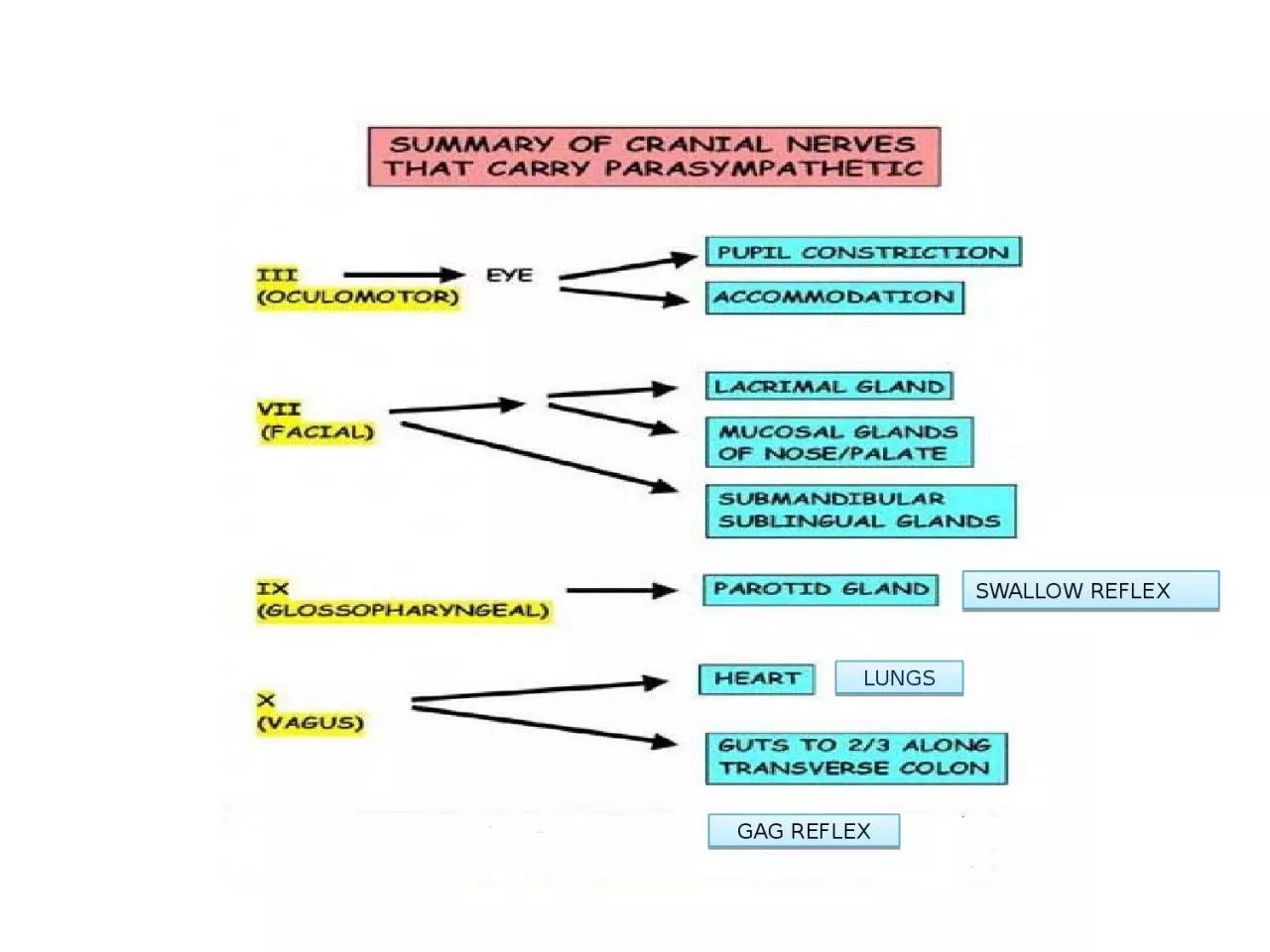

PARASYMPATHETIC CRANIAL NERVES OCULOMOTOR NERVE III Pupil Constriction Pupil constriction is the automatic contraction of the pupil It is done via the oculomotor nerve and sphincter muscle of the iris in response to stimuli such as a bright light shined onto the eye ID: 998580
Download Presentation The PPT/PDF document "LUNGS GAG REFLEX SWALLOW REFLEX" is the property of its rightful owner. Permission is granted to download and print the materials on this web site for personal, non-commercial use only, and to display it on your personal computer provided you do not modify the materials and that you retain all copyright notices contained in the materials. By downloading content from our website, you accept the terms of this agreement.
1. LUNGSGAG REFLEXSWALLOW REFLEX
2. PARASYMPATHETIC CRANIAL NERVESOCULOMOTOR NERVE III- Pupil ConstrictionPupil constriction is the automatic contraction of the pupil. It is done via the oculomotor nerve and sphincter muscle of the iris in response to stimuli such as a bright light shined onto the eye.
3. PARASYMPATHETIC CRANIAL NERVESOCULOMOTOR NERVE III- Pupil AccommodationPupil accommodation is when contraction of the ciliary muscles change the eye's focal distance, making near or far images come into focus on the retina of the eye.
4. PARASYMPATHETIC CRANIAL NERVESFACIAL NERVE VII- Lacrimal GlandThe Facial nerve innervates the Lacrimal gland into producing a moistening fluid for the surface of the eyes. This serves a double function as lubricant and protection, as tears contain lysosomes that are capable of destroying foreign bodies and bacteria.
5. PARASYMPATHETIC CRANIAL NERVESFACIAL NERVE VII- Corneal ReflexWhen the cornea is touched by a foreign object, the eye lids close.
6. PARASYMPATHETIC CRANIAL NERVESFACIAL NERVE VII- Olfactory Bowman's GlandsBowman's glands, otherwise known as the olfactory gland is positioned in the mucous membrane of the nasal cavity. It produces mucus that moistens and lubricates the olfactory epithelium.
7. PARASYMPATHETIC CRANIAL NERVESFACIAL NERVE VII- Submandibular and Sublingual GlandsThe Submandibular and Sublingual glands control the release of saliva into the mouth. The former is responsible for producing up to 65 percent of saliva, while the latter is responsible for producing only up to 5 percent. The Facial nerve innervates both glands.
8. PARASYMPATHETIC CRANIAL NERVESGLOSSOPHARYNGEAL NERVE IX- Parotid GlandThe pair of Parotid glands in the human face are innervated by the Glossopharyngeal nerve, and are responsible for producing the saliva that ends up in the mouth aiding in mastication and food digestion. Swallow reflex initiates by Glossopharyngeal nerve to close the larynx when food touch the entrance of the pharynx.
9. PARASYMPATHETIC CRANIAL NERVESVAGUS NERVE X- OverviewThe Vagus nerve travels from the brain stem down to the abdomen. It is responsible for a variety of important involuntary body functions ranging from maintenance of the heart rate to food digestion.
10. PARASYMPATHETIC CRANIAL NERVESVAGUS NERVE X- The HeartThe Vagus nerve acts to lower the heart rate through the sinoatrial or SA node. By parasympathetic innervation, the Vagus nerve causes acetylcholine to be released.
11. PARASYMPATHETIC CRANIAL NERVESVAGUS NERVE X- From the lung to the digestive systemThe Vagus nerve innervates the smooth muscle of the lung, responsible for bronchoconstriction and secretion of mucus. Vagus nerve innervates the digestive system, responsible for gag reflex, increased peristalsis, glycogen synthesis in the liver. The Vagus nerve also innervates the kidneys, and thus urination.
12. ReferencesLundy-Ekman, L. (2007). Neuroscience: Fundamentals of Rehabilitation. Philadelphia, PA: Elsevier.http://www.medilifenet.com/photo/hn016http://dc349.4shared.com/doc/wvzlE70U/preview_html_7c75c294.gifhttps://classconnechtion.s3.amazonaws.com/857/flashcards/527857/jpg/accomodation1305250857880.jpghttp://www.daviddarling.info/images/lacrimal_gland.gifhttp://image.slidesharecdn.com/thesenseofsmell-110929125027-phpapp01/95/the-sense-of-smell-4-?cb=1728.jpg317319214http://img.tfd.com/MosbyMD/parotid_duct.jpghttp://antranik.org/wp-content/uploads/2011/11/vagus-nerve-x.jpg?9f6b44http://antranik.org/wp-content/uploads/2011/12/external-innervation-heart-vagus-nerve-visceral-sensory-fibers-interneurons-cardioacceleratory-center-cardioinhibitory-center.jpghttp://img.tfd.com/MosbyMD/vagus_nerve.jpghttp://entallergyandsinus.com/wp-content/uploads/2010/12/salivary_glands.jpghttp://www.aliem.com/trick-of-the-trade-corneal-reflex-test/Cranial Nerve SongKing, Pamela. DJLK Production. Retrieved from https://www.youtube.com/watch?v=0lbwshg_Kj4